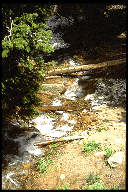
Home
Activity Materials
About this resource
Educational Objectives
Background Science
Mathematics
Run the Model
Glossary of Terms
Credits
Related Links
Contact Webmaster
|
Glossary of Terms |
- Diffusion:
- The process where molecules spread out to form an even concentration.
- Hydrological Soil Group:
- Soil groups which are classified according to
their drainage potential. Group A soils absorb a lot
of water and are deep, well-drained, and composed of sand or gravel.
Conversely, Group D soils do not absorb as much water and have a high
run-off potential, and have a layer of high clay content near the surface or
are shallow soils over bedrock or other material which does not absorb water.
For more info, visit the
Penn State Earth System Science Center Database page on HSG percent
- Hydrologic Condition:
- A rating (good, fair, poor) that is based on a combination of factors that affect infiltration and runoff, including:
- density and canopy of vegetative areas
- amount of year-round ground cover
- amount of grass or close-seeded legumes in rotations
- percent of residue cover on the land surface (good is more than 20%)
- degree of surface roughness
The Explanations page gives a more complete breakdown of good, fair, and poor ratings for different groups of land types.
- Infiltration:
- process of water moving into the soil/ground
- Linearized Rainfall Frequency:
- The likelihood in years that a rainfall
with a given intensity and duration will occur. This is also called the "return
period" or "recurrence interval".
- Nitrogen:
- The 14th of the 107 elements. Nitrogen is important for plant growth and is found in many
commercial fertilizers. It also is found in the environment in different forms (sometimes as a gas, sometimes as a compound with
Oxygen or Hydrogen), from both natural and man-made sources. Because of this, it is often washed through a watershed into a stream or river. If there is
too much Nitrogen in the water, it is a pollutant.
- Percolation:
- water movement through the soil.
- Pollutant: A pollutant is anything which has a bad effect on the environment.
- Runoff:
- Water which is not absorbed by the soil and flows to lower ground, eventually draining into a stream, river, or other body of water.
- Tributary:
- A stream or river whose water flows into a larger stream or river.
- Watershed:
- The sum total of all the land and smaller bodies of water which drains into a particular stream or river.
- Water-soluble:
- capable of being dissolved in water
|
|

